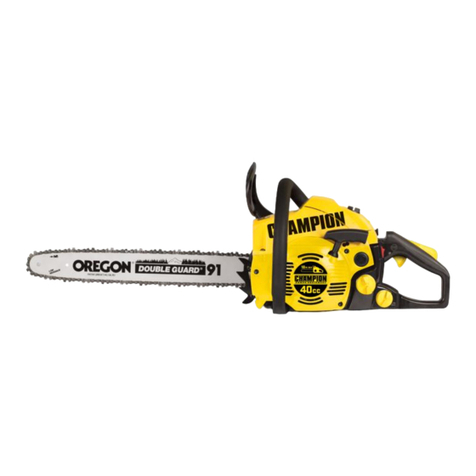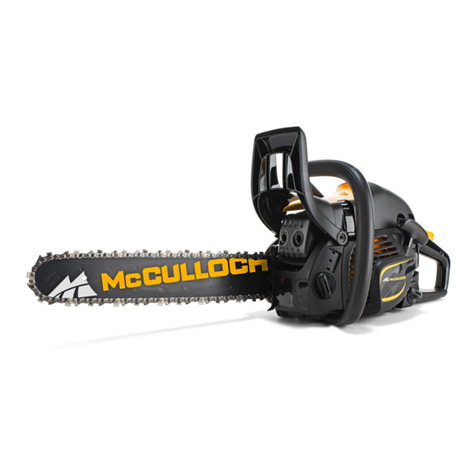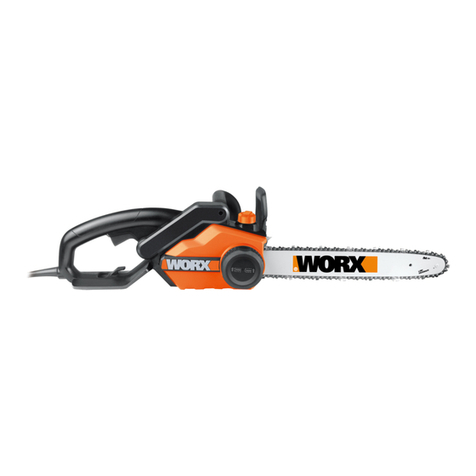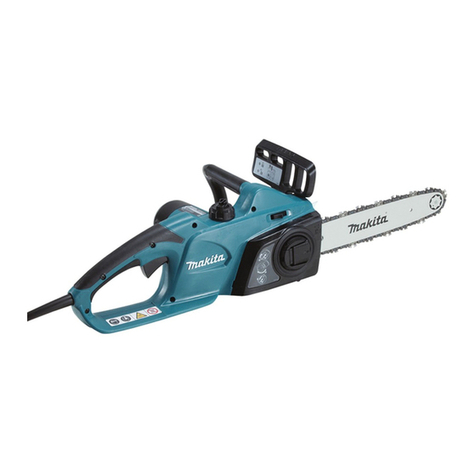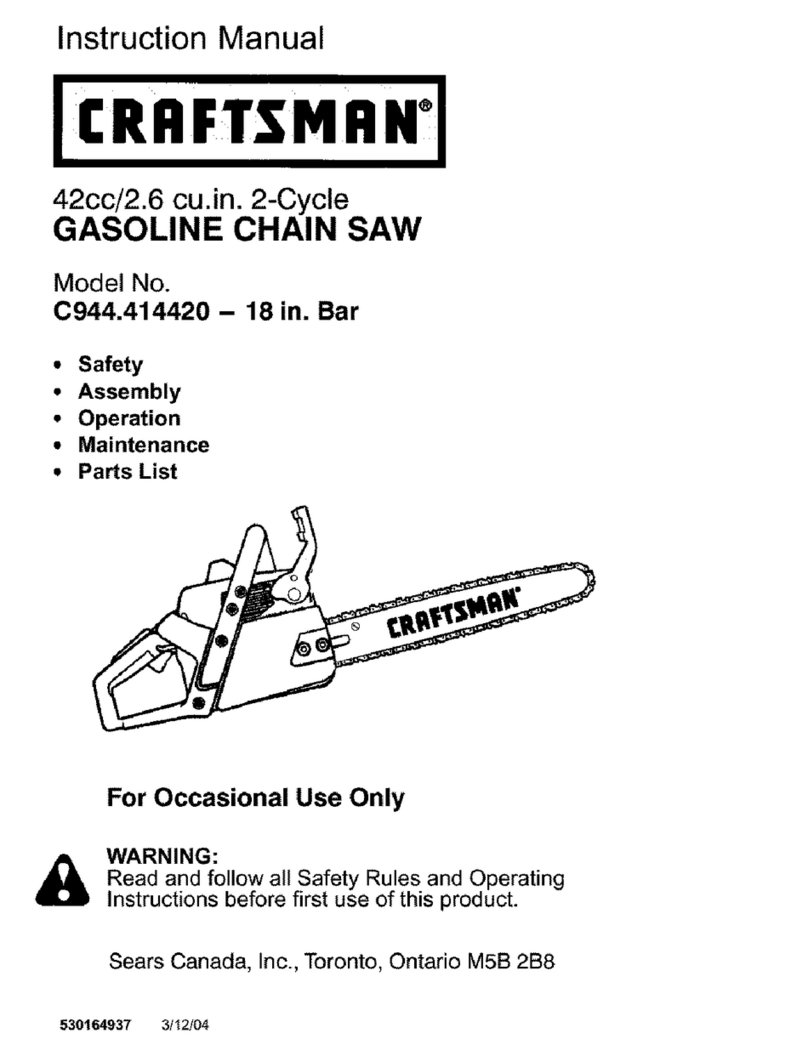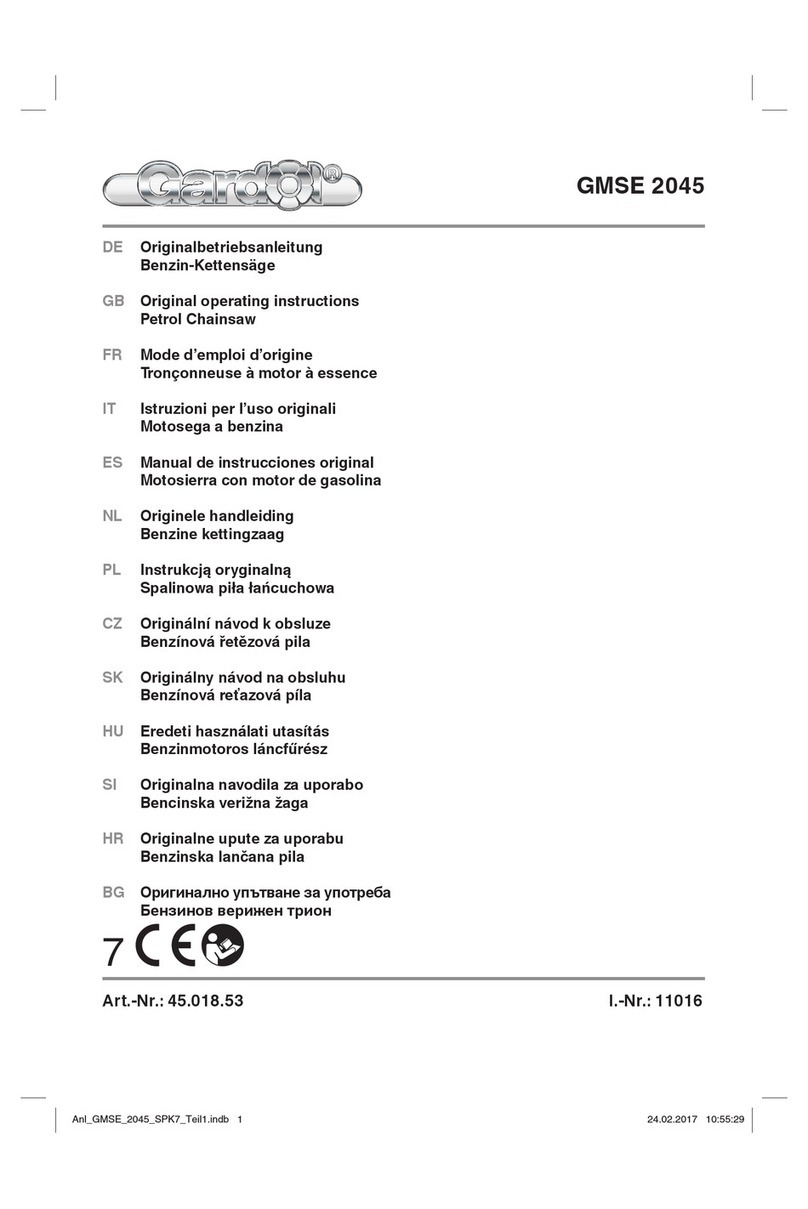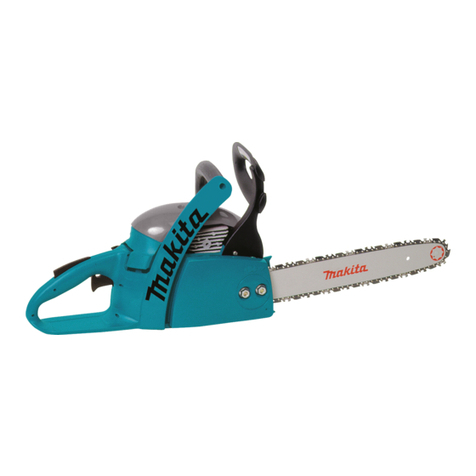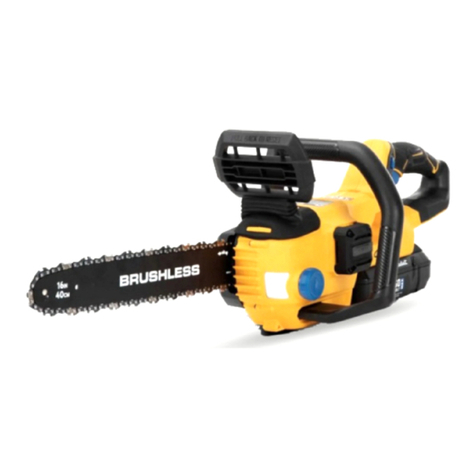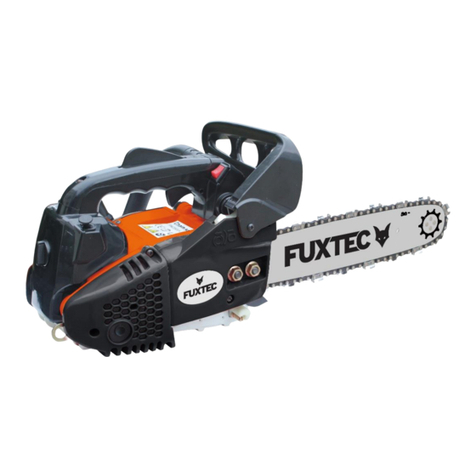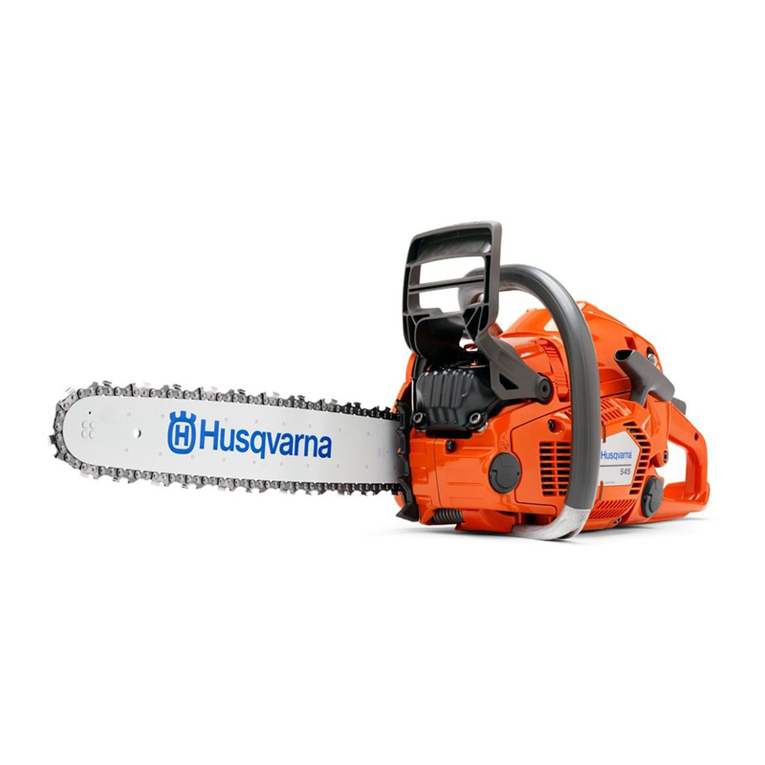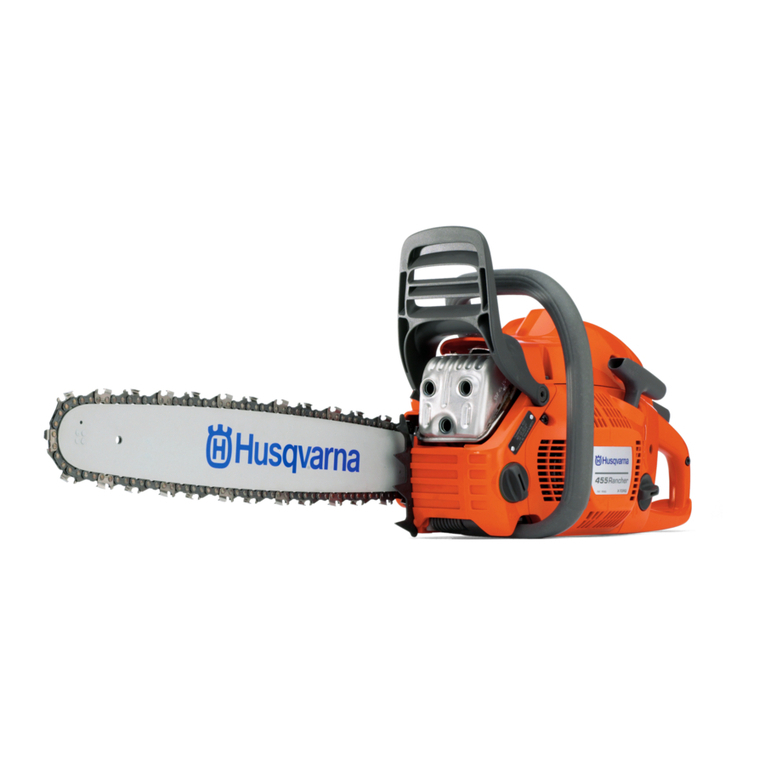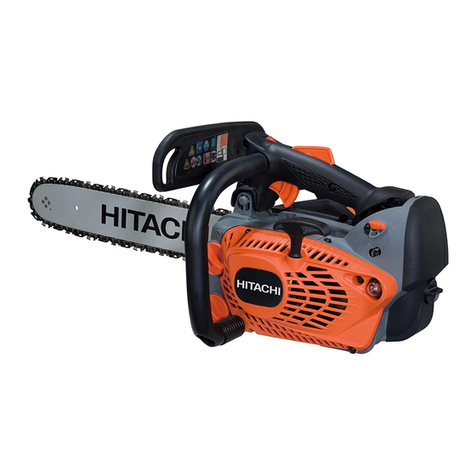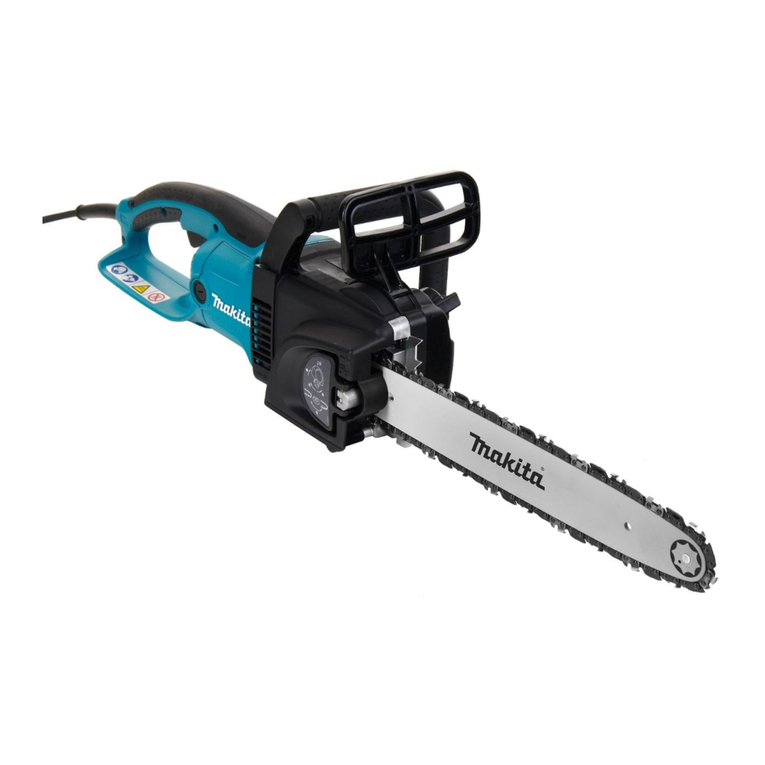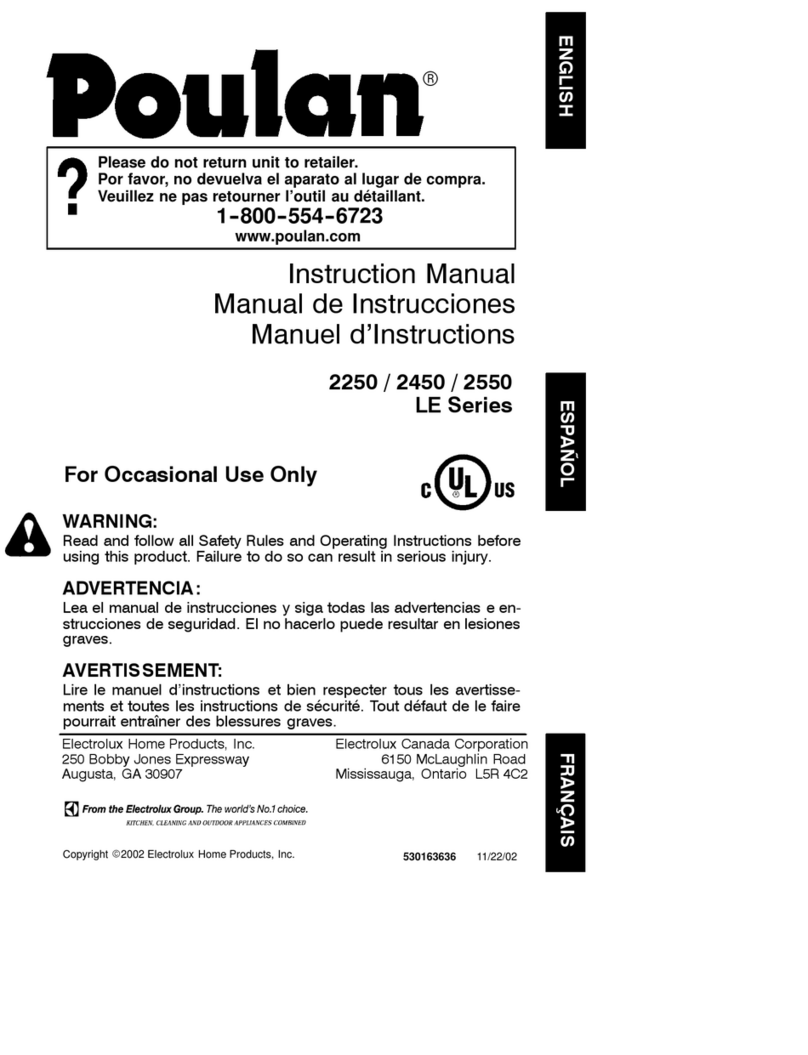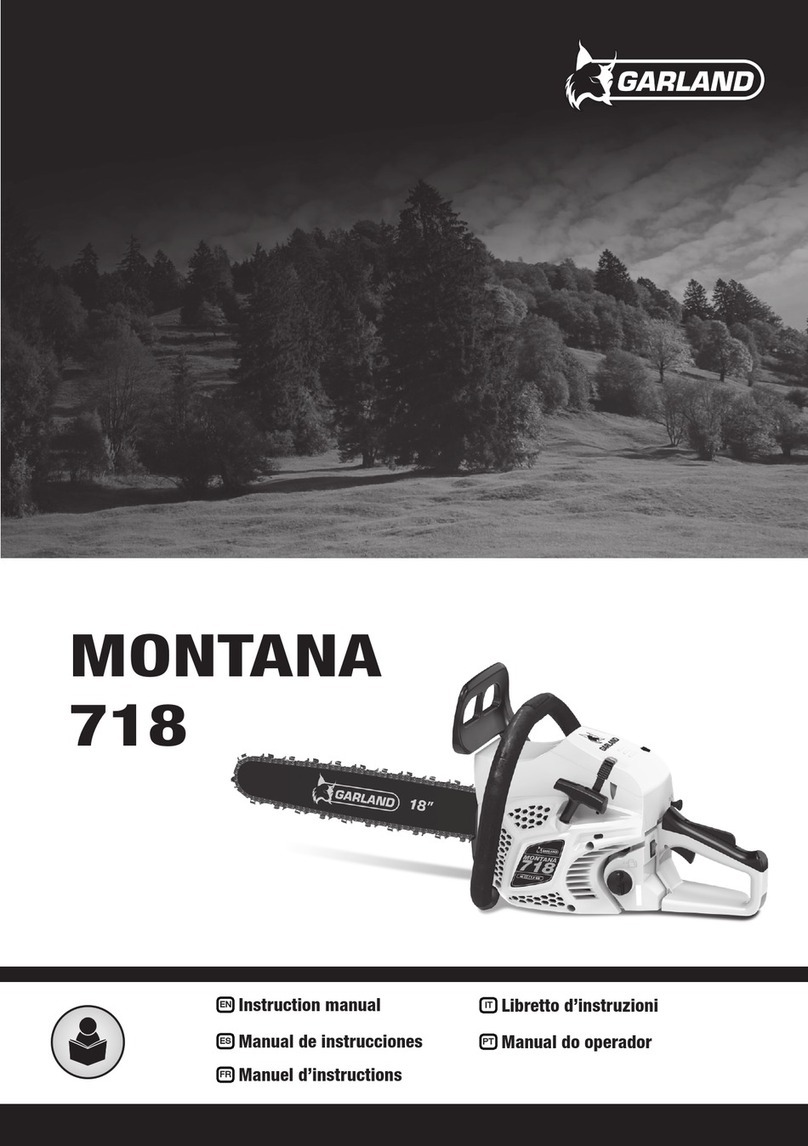Champion Power Equipment 100647 User manual

OPERATOR'S MANUAL
MODEL #100647
CHAINSAW
REV 20210508 Champion Power Equipment, Inc., Santa Fe Springs, CA USA
or visit championpowerequipment.com
READ AND SAVE THIS MANUAL. This manual contains important safety precautions which should be read and understood before operating the product. Failure to
do so could result in serious injury. This manual should remain with the product.
Specifications, descriptions and illustrations in this manual are as accurate as known at the time of publication, but are subject to change without notice.
REGISTER YOUR PRODUCT ONLINE
at championpowerequipment.com

2
100647 - CHAINSAW TABLE OF CONTENTS
TABLE OF CONTENTS
Introduction................................................... 3
Safety Definitions .......................................... 3
Important Safety Instructions....................... 4
Safety Warnings for Gasoline Powered Chainsaw ................4
While Operating ....................................................4
Kickback Safety ....................................................5
Other Safety Warnings .............................................7
Safety Labels.......................................................8
Safety Symbols.....................................................9
Quickstart Label Symbols........................................ 10
Controls and Features ................................. 11
Chainsaw ......................................................... 11
Safety Features .................................................. 12
Parts Included .................................................... 12
Assembly ..................................................... 13
Adding Bar and Chain Oil: Initial Use ............................ 13
Adjusting the Chain Tension: Initial Use ......................... 13
Oil and Fuel Mixing Instructions ................................. 13
Operation..................................................... 14
Starting and Stopping............................................ 14
Tips for Best Results ............................................. 16
Preparing the Work Area......................................... 16
Holding the Chainsaw ............................................ 16
Wedges and Recommended Tools............................... 17
Cutting Procedure Basics........................................ 18
Felling: Safety .................................................... 18
Felling: Procedure ................................................ 18
Limbing ........................................................... 20
Bucking: Safety .................................................. 20
Bucking: Procedure .............................................. 20
Pruning ........................................................... 21
Maintenance ................................................ 22
Maintenance Schedule........................................... 22
Adding Bar and Chain Oil ........................................ 22
Adjusting the Bar And Chain Oil Flow ........................... 23
Adjusting the Chain Tension ..................................... 23
Removing and Installing the Guide Bar and Saw Chain......... 25
Maintaining the Saw Chain ...................................... 26
Sharpening the Saw Chain....................................... 26
Maintaining the Guide Bar ....................................... 27
Lubricating the Guide Bar Sprocket Tip ......................... 28
Replacing the Guide Bar and Saw Chain ........................ 28
Maintaining the Air Filter......................................... 29
Adjusting the Idle Speed ......................................... 29
Maintaining the Spark Plug ...................................... 30
Cleaning .......................................................... 30
Storage ........................................................ 31
Long-term Storage (30 days or more)........................... 31
Preparing the Chainsaw for Use after
Long-term Storage................................................. 31
Specifications.............................................. 32
Chainsaw Specifications ......................................... 32
Replacement Parts ............................................... 32
Troubleshooting........................................... 33

3
100647 - CHAINSAW INTRODUCTION
INTRODUCTION
Congratulations on your purchase of a Champion Power Equipment
(CPE) product. CPE designs, builds, and supports all of our
products to strict specifications and guidelines. With proper
product knowledge, safe use, and regular maintenance, this
product should bring years of satisfying service.
Every effort has been made to ensure the accuracy and
completeness of the information in this manual at the time of
publication, and we reserve the right to change, alter and/or
improve the product and this document at any time without prior
notice.
Since CPE highly values how our products are designed,
manufactured, operated and are serviced, and also highly value
your safety and the safety of others, we would like you to take the
time to review this product manual and other product materials
thoroughly and be fully aware and knowledgeable of the assembly,
operation, dangers and maintenance of the product before use.
Fully familiarize yourself, and make sure others who plan on
operating the product fully familiarize themselves too, with the
proper safety and operation procedures before each use. Please
always exercise common sense and always err on the side
of caution when operating the product to ensure no accident,
property damage, or injury occurs. We want you to continue to use
and be satisfied with your CPE product for years to come.
When contacting CPE about parts and/or service, you will need to
supply the complete model and serial numbers of your product.
Transcribe the information found on your product’s nameplate
label to the table below
CPE TECHNICAL SUPPORT TEAM
1-877-338-0999
MODEL NUMBER
100647
SERIAL NUMBER
DATE OF PURCHASE
PURCHASE LOCATION
SAFETY DEFINITIONS
The purpose of safety symbols is to attract your attention to
possible dangers. The safety symbols, and their explanations,
deserve your careful attention and understanding. The safety
warnings do not by themselves eliminate any danger.
The instructions or warnings they give are not substitutes for
proper accident prevention measures.
DANGER
DANGER indicates a hazardous situation which, if not avoided,
will result in death or serious injury.
WARNING
WARNING indicates a hazardous situation which, if not
avoided, could result in death or serious injury.
CAUTION
CAUTION indicates a hazardous situation which, if not avoided,
could result in minor or moderate injury.
NOTICE
NOTICE indicates information considered important, but not
hazard-related (e.g., messages relating to property damaged).

4
100647 - CHAINSAW IMPORTANT SAFETY INSTRUCTIONS
IMPORTANT SAFETY INSTRUCTIONS
Read all instructions before operating.
WARNING
When using the chainsaw, all safety rules must be followed.
Please read these instructions before operating the chainsaw
in order to ensure the safety of the operator and any
bystanders. Please keep these instructions for later use.
–Read the instructions carefully. Be familiar with the controls
and proper use of the chainsaw. Know how to stop the
chainsaw and disengage the controls quickly.
–Do not operate this chainsaw when tired, ill or under the
influence of alcohol, drugs or medication.
WARNING
Fatigue causes carelessness. Be more cautious before rest
periods and towards the end of your shift.
–Never allow children to operate the chainsaw. Never allow
adults to operate the chainsaw without proper instruction.
–All guards and safety attachments must be installed properly
before operating the chainsaw.
–Inspect the chainsaw before use. Replace damaged parts.
Check for fuel leaks. Make sure all fasteners are in place
and secure. Replace parts that are cracked, chipped, or
damaged in anyway. Do not operate the chainsaw with loose
or damaged parts.
–Be aware of risk of injury to the head, hands and feet.
–Carefully inspect the area before starting the chainsaw.
Remove rocks, broken glass, nails, wire, string and other
objects that may be thrown or become entangled with the
chainsaw.
–Clear the area of children, bystanders and pets; keep them
outside a 50-foot (15m) radius, at a minimum. Even then, they
are still at risk from thrown objects. Encourage bystanders to
wear eye protection. If you are approached, stop the chainsaw
immediately.
–Squeeze the throttle control and check that it returns
automatically to the idle position. Make all adjustments or
repairs before using the chainsaw.
Safety Warnings for Gasoline Powered
Chainsaw
WARNING
When using the chainsaw, all safety rules must be followed.
Please read these instructions before operating the chainsaw
in order to ensure the safety of the operator and any
bystanders. Please keep these instructions for later use.
–Store fuel only in containers specifically designed and
approved for the storage of such materials.
–Always stop the engine and allow it to cool before filling the
tank. Never remove the fuel tank cap or add fuel when the
engine is hot. Always loosen the fuel tank cap slowly to relieve
any pressure in the tank before fueling.
–Always mix and add fuel in a clean, well-ventilated outdoor
area where there are no sparks or flames. DO NOT smoke.
–Never operate the chainsaw without the fuel cap securely in
place.
–Avoid creating a source of ignition for spilled fuel. Wipe up any
spilled fuel from the chainsaw immediately, before starting
the chainsaw. Move the chainsaw at least 30 ft. (9.1 m) from
the fueling source and site before starting the engine. DO NOT
smoke.
–Never start or run the chainsaw inside a closed room or
building. Breathing exhaust fumes can kill. Operate this
chainsaw only in a well ventilated outdoor area.
While Operating
WARNING
The following safety instructions must be observed while
operating your chainsaw.
–When a chainsaw is being used, a fire extinguisher should be
available.
–Wear safety glasses or goggles that meet current ANSI Z87.1
standards and are marked as such.
Wear ear/hearing protection when operating this chainsaw.
Wear a face mask or dust mask if the operation is dusty. Use a
hard hat or other type of safety helmet.
–Wear safety boots and protective gloves. Wear heavy, snug-
fitting clothes, including long pants and a long-sleeve shirt.
Do not wear loose clothing, jewelry, short pants, sandals or go
barefoot. Secure hair above shoulder level.
–Make sure the saw chain is not in contact with anything before
starting the chainsaw.
–Use the chainsaw only in daylight or good artificial light.

5
100647 - CHAINSAW IMPORTANT SAFETY INSTRUCTIONS
–Avoid accidental starting. Be in the starting position whenever
pulling the starter rope. The operator and chainsaw must be in
a stable position while starting. Refer to Starting and Stopping.
–Only use this chainsaw for its intended purpose: to cut wood.
Do not use the chainsaw for cutting plastic, masonry or
other non-wood building materials. Only use the chainsaw as
described in this manual.
–Keep all body parts away from the saw chain when the
chainsaw is running. Do not touch or try to stop moving parts.
–When carrying a chainsaw with the engine running always
engage the chain brake.
–Do not touch the engine or muffler. These parts get extremely
hot from operation, even after the chainsaw is turned off.
–Do not operate the chainsaw faster than the speed needed to
do the job. Do not run the chainsaw at high speed when not in
use.
–Do not force the chainsaw, especially near the end of a cut. It
will do a better, safer job when used at the intended rate.
–Always turn the engine off when operation is delayed, when
setting the chainsaw down or when carrying the chainsaw
from one location to another. Make sure all moving parts come
to a complete stop.
–Carry the chainsaw by the front handle with the muffler
positioned away from the body and the guide bar positioned to
the rear. Cover the guide bar and saw chain with the scabbard
when carrying the chainsaw.
–If you strike or become entangled with a foreign object, stop
the chainsaw immediately and check for damage. Do not
operate the chainsaw before repairing damage. Do not operate
the chainsaw with loose or damaged parts.
–Use only original equipment manufacturer (OEM) replacement
parts and accessories for this chainsaw. These are available
from Champion or other qualified service dealer. Use of any
other parts or accessories could lead to injury to the user,
or damage to the chainsaw, and void the warranty.
–Keep the chainsaw clean. Carefully remove vegetation and
other debris that could block moving parts.
–To reduce fire hazard, replace a faulty muffler and spark
arrestor. Keep the engine and muffler free from grass, leaves,
excessive grease or carbon build up.
–If the chainsaw starts to vibrate abnormally, stop the chainsaw
immediately. Inspect the chainsaw for the cause of the
vibration. Vibration is generally an indicator of trouble.
–Keep the work area clean. Cluttered areas invite injuries.
Do not start cutting until the work area is clear and free from
obstructions. Make sure there is secure footing and a planned
retreat path from falling trees or branches.
–Do not cut near electrical cables or power lines. Keep at least
50 feet (15 m) away from all power lines.
–For safer, more effective performance, make sure the guide
bar and chain are properly cleaned, lubricated, tightened and
sharpened. Check the guide bar and chain at frequent intervals
for proper adjustment.
–When cutting a limb that is under tension, use extreme
caution. When the tension is released, the limb could spring
back and strike the operator, causing severe injury or death.
–Use extreme caution when cutting small-sized brush and
saplings, as slender material may catch the saw chain and be
whipped toward the operator or pull the operator off balance.
–This saw is classified by UL as a Class 1C saw in accordance
with CSA Z62.1-03. It is intended for infrequent use by
homeowners, cottagers and campers, and for general
applications such as clearing, pruning, cutting firewood, etc.
It is not intended for prolonged use. If the intended use
involves prolonged periods of operation, this may cause
circulatory problems in the user’s hands due to vibration.
–Do not operate the chainsaw in a tree or on a ladder unless
specifically trained to do so.
–Never remove, modify or make inoperative any safety device
furnished with the chainsaw.
–Do not use the chainsaw in the presence of flammable liquids
or gases.
–Do not attempt operations beyond the operator’s capacity or
experience.
–Do not operate a chainsaw that is damaged, improperly
adjusted or not completely and securely assembled. Make sure
moving parts stop when the throttle control trigger is released
or the chainsaw is turned off. Do not use the chainsaw if
it does not turn on and off properly. Have defective parts
replaced by Champion or other qualified service dealer.
Kickback Safety
WARNING
Kickback may occur when the nose or tip of the guide bar
touches an object, or when the wood closes in and pinches
the saw chain in the cut. In some cases, tip contact may cause
a lightening-fast reverse action, kicking the guide bar rapidly
back to wards the operator. Pinching the saw chain along
the top of the guide bar may push the guide bar rapidly back
towards the operator. Either of these reactions may cause
a loss of control over the saw, which could result in serious
injury to the user. Contact with foreign objects within the wood
can also induce a loss of chain saw control.

6
100647 - CHAINSAW IMPORTANT SAFETY INSTRUCTIONS
Understanding Kickback
A basic understanding of kickback can help reduce or eliminate
the element of surprise and the chance of kickback-related injury.
Sudden surprise contributes to accidents.
–Rotational Kickback can happen when the upper tip of
the guide bar contacts an object while the chain is moving
(Fig. A). This can cause the chain to dig into the object and
momentarily stop moving. The guide bar is then kicked up and
back toward the operator in a lightning-fast reverse reaction.
–Linear Kickback can happen when the wood on either side
of a cut closes in and pinches the moving saw chain along
the top of the guide bar (Fig. B). This can cause the chain
to instantly stop. The chain force is then reversed, causing
the saw to move in the opposite direction, sending the saw
straight back toward the operator.
–Pull-In can happen when the moving chain on the bottom
of the guide bar hits a foreign object inside the wood. This
can cause the chain to suddenly stop. The saw is then pulled
forward and away from the operator, which could potentially
result in the loss of control of the saw.
Fig. A
Fig. B
Rotational
Kickback
Kickback
Danger Zone
Saw Chain
Direction
Linear
Kickback
Pinch
Figure A
Fig. A
Fig. B
Rotational
Kickback
Kickback
Danger Zone
Saw Chain
Direction
Linear
Kickback
Pinch
Figure B
Kickback Safety Precautions
Take the following steps to reduce the chance of accident or
injury:
–Do not rely exclusively upon the safety devices built into the
chainsaw.
–Do not cut above shoulder height.
–Do not over reach. Always keep proper footing and balance.
Take extra care when working on steep slopes or inclines.
–Do not make cuts with the tip of the guide bar.
–Make sure the area of operation is free from obstructions.
Do not let the tip of the guide bar contact any object, such as a
log, branch, the ground or other obstruction.
–Always inspect the wood before cutting. Foreign objects could
damage the chainsaw or cause serious personal injury. Never
cut through nails, metal rods, railroad ties or pallets.
–Do not operate the chainsaw with one hand! Serious injury to
the operator, helpers or bystanders may result from one-
handed operation. This chainsaw is intended for two-handed
use. Always grip the chainsaw firmly with both hands when
the chainsaw is running. Hold the front handle with the left
hand and the rear handle with the right hand. Firmly encircle
the handles with the thumbs and fingers. Do not let go. A firm
grip will help maintain control of the chainsaw and reduce the
chance of kickback.
–Stand slightly to the left of the chainsaw to avoid being in the
direct line of the saw chain.
–Never start the saw when the guide bar is inside an existing
cut. Be extremely careful when re-entering a cut.
–Always begin a cut with the chainsaw running at full speed.
Fully squeeze the throttle control and maintain a steady cutting
speed. Slower speeds increase the chance of kickback.
–Keep the saw housing pressed firmly against the wood.
–Do not cut more than one log or branch at a time.
–Do not twist the chainsaw when removing the guide bar from
a cut.
–Watch out for shifting objects (logs, branches, etc.) that might
pinch or fall onto the saw chain during operation.
–Only use wedges made of wood or plastic. Do not use metal to
hold a cut open.
–Follow the manufacturer’s sharpening and maintenance
instructions for the saw chain.
–Only use replacement bars and chains specified by the
manufacturer or the equivalent. These are available from
Champion or other qualified service dealer. Use of any
unauthorized parts or accessories could lead to serious injury
to the operator or damage to the chainsaw and will void the
warranty.
–Use devices that reduce the risks associated with
kickback,such as low-kickback chains, guide bar nose guards,
chain brakes and low-kickback guide bars. There are no other
replacement components for achieving kickback protection in
accordance with CSA Z62.3.

7
100647 - CHAINSAW IMPORTANT SAFETY INSTRUCTIONS
–A low-kickback saw chain is a chain that has met the kickback
performance requirements of ANSI/OPEI B175.1-2012 when
tested according to the provisions specified in ANSI/OPEI
B175.1-2012. A low-kickback saw chain is a chain that is also
in accordance with CSA Z62.3. Do not use a replacement saw
chain unless it has met these requirements for this specific
model or has been designated as a low-kickback replacement
saw chain in accordance with ANSI/OPEI B175.1-2012. As saw
chains are sharpened, some of the low-kickback qualities are
lost and extra caution should be used.
–Do not install a bow guide on this chainsaw. Bow guides have
larger kickback zones, which increase the chance of kickback
and serious injury. This increase is not significantly reduced
by using a low-kickback saw chain. Using a bow guide on this
chainsaw is extremely dangerous.
Other Safety Warnings
–Follow all maintenance instructions in this manual.
–All service, other than the maintenance procedures described
in this manual, should be performed by a Champion qualified
service dealer.
–Do not use the chainsaw if it is not working correctly, has been
dropped, damaged, left outdoors or dropped into water. Have
the chainsaw serviced by a Champion qualified service dealer.
Before inspecting, servicing, cleaning, storing, transporting or
replacing any parts on the chainsaw:
1. Stop the chainsaw.
2. Make sure all moving parts have stopped.
3. Allow the chainsaw to cool.
4. Disconnect the spark plug wire.
–Secure the chainsaw while transporting.
–Always use the scabbard on the guide bar and saw chain
during transportation and storage.
–Always store the chainsaw and fuel in a cool, dry and well-
ventilated space. Do not store fuel, or a chainsaw with fuel in
the tank, indoors where fumes may reach open flames (pilot
lights, etc.) or sparks (switches, electrical motors, etc.).
–Store the chainsaw in a dry place, secured or at a height to
prevent unauthorized use or damage. Keep the chainsaw out of
the reach of children.
–Never douse or squirt the chainsaw with water or any other
liquid. Keep handles dry, clean and free from debris, oil,
fuel and grease. Clean the chainsaw after each use. Refer
to Cleaning and Storage. Do not use solvents or strong
detergents.
–Keep these instructions. Refer to them often and use them
to instruct other users. If you loan this chainsaw to others, also
loan them these instructions.
SAVE THESE INSTRUCTIONS
WARNING
This spark ignition system complies with the ICES-002.
NOTICE
For users on U.S. Forest Land and in the states of
California, Maine, Oregon and Washington. All U.S.
Forest Land and the state of California (Public Resources
Codes 4442 and 4443), Oregon and Washington require, by
law that certain internal combustion engines operated on
forest brush and/or grass-covered areas be equipped with
a spark arrestor, maintained in effective working order, or
the engine be constructed, equipped and maintained for the
prevention of fire. Check with your state or local authorities
for regulations pertaining to these requirements. Failure to
follow these requirements could subject you to liability or a
fine. This chainsaw is factory equipped with a spark arrestor.
Replacement requires a Muffler Assembly, installed at a
Champion Parts & Repair Service Center.

8
100647 - CHAINSAW IMPORTANT SAFETY INSTRUCTIONS
Top view
Safety Labels
These labels warn you of potential hazards that can cause serious injury. Read them carefully.
If a label comes off or becomes hard to read, contact Technical Support Team for possible replacement.
Top view
LABEL DESCRIPTION
A
1786-L-SF-D
45
−Only use approved bar and chain combination.
−Bar/Chain Oregon, type 180SDEA041 / 91P062X.
−Sprocket (teeth ×pitch): 6T ×3 / 8”LP.
− Class 1C
− Use of non-approved bar, chain or sprocket will void
warranty, damage the saw and could cause physical
harm.
−
−
−
−
−
Utilisez uniquement la combinaison de barre et de
chaîne approuvée.
Bar / Chaîne Oregon, type 180SDEA041 / 91P062X.
Pignon (dents ×pas) : 6T ×3/8 ” L P.
Clase 1C
L’utilisation d’une barre, d’une chaine ou d’un
pignon non approuve annulera la garantie,
endommargera la scie et pourrait causer des
blessures.
WARNING AVERTISSEMENT
---
ColorsLPN 1786-L-SF
Rev D
Size 45 x 33 mm
Artwork Notes
3mm corner radius; 2mm safe margin;
to be printed
on white substrate
Revision Changes
B- revised lineart
C- change 91P063X to 91P062X
D - change 0.375 in. to 3/8”LP
This artwork belongs to Champion Power Equipment. The contents are confidential and privileged and shall not be disclosed to or used by or for
outside parties without the explicit consent of Champion Power Equipment.
K2945485152
Safety Symbols
B
MANUFACTURE DATE
DATE DE FABRICATION
SERIAL NO.
N° DE SÉRIE
MODEL
MODÉLE 100XXX
CHAMPION POWER EQUIPMENT, INC.
12039 SMITH AVENUE, SANTA FE SPRINGS,
CA 90670, USA / É.-U. 1-877-338-0999
MADE IN CHINA / FABRIQUÉ EN CHINE
Conforms to / Obéir àOPEI B175.1
Certified to / Certifier àCSA z62.1. z62.3 1696-L-PR-A 5005032
--- --- --- ---
ColorsLPN 1696-L-PR
Rev A
Size 70 x 35 mm
Artwork Notes
2mm safe margin; to be printed on security
substrate
; magenta text should be filled in during
time of production.
Revision Changes
---
This artwork belongs to Champion Power Equipment. The contents are confidential and privileged and shall not be disclosed to or used by or for
outside parties without the explicit consent of Champion Power Equipment.
K
XXXXXXXXXXXX
XXXX
Dataplate
C
Made in China / Fabriqué en Chine
Always wear protective gear. Do not
wear loose fitting clothing. / Portez
toujoursde l’équipement de protection.
Ne portez pas de vêtements amples.
Read operator’s manual
before operating saw. / Lisez
le manuel d’utilisation avant
d’utiliser la scie.
WARNING
AVERTISSEMENT
1811-L-OP-B
10-20X 1-4X
9
8765
1 2 3 4
1-4X
--- ---
ColorsLPN 1811-L- OP
Rev B
Size 38 x 136 mm
Artwork Notes
2mm safe margin;
to be printed on white substrate.
Revision Changes
---
This artwork belongs to Champion Power Equipment. The contents are confidential and privileged and shall not be disclosed to or used by or for
outside parties without the explicit consent of Champion Power Equipment.
K2945152
Quick Start
C
A
B

9
100647 - CHAINSAW IMPORTANT SAFETY INSTRUCTIONS
Safety Symbols
Some of the following symbols may be used on this product. Please study them and learn their meaning. Proper interpretation of these
symbols will allow you to more safely operate the product.
SYMBOL MEANING
Read Operator’s Manual. To reduce the risk of injury, user must read and understand operator’s
manual before using this product.
Eye and Ear Protection. Always wear safety goggles or safety glasses with side shields, and as
necessary a full face-shield as well as full ear protection when operating this product.
Kickback. Contact of the guide bar tip with any object should be avoided. Tip contact may cause
the guide bar to move suddenly upward and backward, which may cause serious injury.
CKA. Computed kickback angle (CKA) listed represents angle of kickback your bar and chain will
have when tested in accordance with CSA (Canadian Standards Association) and ANSI standards.
The bar and chain combination meet kickback requirements of CSA Standards Z62.1, Z62.3, &
ANSI/OPEI B175.1 when used as shown in Specifications. Use of bar and chain combinations
other than those listed is not recommended and may not meet the CKA requirements per
standard.
Use Both Hands. Always use both hands while operating the chainsaw. Never use only one hand
to operate the chainsaw.
Chain Direction. Make sure the saw chain faces the direction shown when installed on the guide
bar. Refer to Installing the Guide Bar and Saw Chain in the Maintenance section.

10
100647 - CHAINSAW IMPORTANT SAFETY INSTRUCTIONS
Quickstart Label Symbols
Some of the following symbols may be used on this product. Please study them and learn their meaning. Proper interpretation of these
symbols will allow you to more safely operate the product.
Starting the Engine
1. Make sure chain break is engaged.
2. Push the purge bulb at least 10-20 times, or until bulb is full
of fuel.
3. Pull the choke knob out until a “click” is heard.
4. Pull the starter rope rapidly 1-4 times or until the engine
pops.
5. Push the choke knob in.
6. Pull the starter rope rapidly 1-4 times to start the engine. If
the engine does not start, repeat steps 3-6.
7. When engine starts, ensure the choke knob is pushed in and
press and hold the throttle lockout and lightly squeeze the
throttle to idle the engine.
8. Allow the engine to warm up for 30-60 seconds.
9. Carefully disengage the chain brake.
Made in China / Fabriqué en Chine
Always wear protective gear. Do not
wear loose fitting clothing. / Portez
toujoursde l’équipement de protection.
Ne portez pas de vêtements amples.
Read operator’s manual
before operating saw. / Lisez
le manuel d’utilisation avant
d’utiliser la scie.
WARNING
AVERTISSEMENT
1811-L-OP-B
10-20X 1-4X
9
8765
1 2 3 4
1-4X
--- ---
ColorsLPN 1811-L-OP
Rev B
Size 38 x 136 mm
Artwork Notes
2mm safe margin;
to be printed on white substrate.
Revision Changes
---
This artwork belongs to Champion Power Equipment. The contents are confidential and privileged and shall not be disclosed to or used by or for
outside parties without the explicit consent of Champion Power Equipment.
K2945152

11
100647 - CHAINSAW CONTROLS AND FEATURES
CONTROLS AND FEATURES
Read this operator’s manual before operating your chainsaw. Familiarize yourself with the location and function of the controls and
features. Save this manual for future reference.
Chainsaw
1. Guide Bar
2. Saw Chain
3. Front Hand Guard and Chain Brake Lever
4. Front Handle
5. Air Filter Cover
6. Air Cleaner Cover Knob
7. Choke Knob
8. Throttle Trigger Lockout
9. Rear Handle
10. Throttle Trigger
11. Engine Switch
12. Bar and Chain Oil Tank
13. Fuel Tank
14. Starter Handle
15. Purge Bulb
16. Clutch Cover
17. Chain Tensioning Screw
1 2
4
12
16 17
1314
15
5
6
7
8
1011
3
9

12
100647 - CHAINSAW CONTROLS AND FEATURES
Safety Features
1. Low-Kickback Saw Chain – significantly reduces the
chance of kickback and the intensity of kickback, due to
specially designed depth gauges and guard links.
2. Spark Arrester Screen – retains carbon and other
flammable particles over 0.023 inches (0.6 mm) in size from
the engine exhaust flow. Compliance with local, state and
federal laws and/or regulations governing the use of a spark
arrester screen is the user’s responsibility. Refer to spark
arrestor note in the safety section for additional information.
3. Chain Brake Lever / Front Hand Guard – helps protects the
operator’s left hand if it slips off the front handle while the
chainsaw is running. The chain brake lever is also used to
manually engage the chain brake.
4. Chain Brake – reduces the chance of injury if kickback
occurs, by stopping the saw chain in milliseconds. The chain
brake is designed to engage automatically in response to
kickback. The chain brake can also be activated by pushing
the chain brake lever forward, either intentionally or if the
operator’s hand strikes the lever during kickback.
5. On/Off Switch – immediately stops the engine when moved
to the off position. The on/off ignition switch automatically
springs back to the on position to be ready to start the engine
for next use.
6. Throttle Lockout – prevents accidental acceleration of the
engine. The throttle control cannot be squeezed unless the
throttle lockout is depressed.
7. Chain Catcher – reduces the chance of injury if the saw
chain breaks or derails during operation. The chain catcher is
designed to intercept a whipping chain.
Parts Included
–Chainsaw
–Chainsaw Case
–Gloves
–Scrench
–2-cycle oil
–Bar and chain oil

13
100647 - CHAINSAW ASSEMBLY
ASSEMBLY
Adding Bar and Chain Oil: Initial Use
This chainsaw comes from the factory with the chain oil reservoir
empty. Refer to Adding Bar and Chain Oil instructions in the
Maintenance section.
Adjusting the Chain Tension: Initial Use
The saw chain must be properly tensioned before attempting
to start or operate the chainsaw. The saw chain may also
require additional tensioning as the saw chain heats up during
operation. Refer to Adjusting the Chain Tension instructions in the
Maintenance section.
Testing the Chain Brake
WARNING
Always activate the chain brake slowly and deliberately. Keep
the saw chain from touching anything. Do not let the chain saw
tip forward.
Always test the chain brake before using the chainsaw.
1. Set the chainsaw on a flat, level surface.
2. Make sure the chain brake lever is pulled back in the
disengaged position (Fig. 1).
3. Start the chainsaw. Refer to Starting Instructions in the
Starting and Stopping section. Maintain a proper grip. Refer
to Holding the Chainsaw in the Operation section.
4. While the chainsaw is running, squeeze the throttle control
to 1/3 throttle and then engage the chain brake by pushing
the chain brake lever forward with the left hand (Fig. 1). The
chain should stop moving abruptly.
IF... If the chain stops moving, the chain brake is working
correctly.
IF... If the chain does not stop moving, have the chainsaw
serviced by Champion or other qualified service dealer.
5. Stop the engine and return the chain brake to the disengaged
position. Refer to Stopping Instructions in the Starting and
Stopping section.
Disengaged Engaged
Chain Brake Lever
Figure 1
Oil and Fuel Mixing Instructions
The use of old and/or improperly mixed fuel is the most common
cause of performance problems. Always use fresh, clean unleaded
gasoline (less than 30 days old). Follow these instructions
carefully for the proper gasoline/oil mixture.
Definition of Blended Fuels
Today’s fuels are often a blend of gasoline and oxygenates such as
ethanol. Alcohol-blended fuel absorbs water. As little as 1% water
in the fuel can make fuel and oil separate, forming acids when
stored.
NOTICE
Dispose of old fuel according to federal, state and local
regulations.
Using Blended Fuels and Fuel Additives
–ALWAYS use fresh fuel less than 30 days old with a 2-cycle oil
designed for air-cooled engines and mix it with a fuel additive,
such as STA-BIL Fuel Stabilizer or an equivalent.
–Adding a fuel stabilizer will inhibit corrosion and minimize the
formation of gum deposits from forming harmful deposits in
the carburetor. Add 0.8 oz. (23mL) of fuel additive per gallon of
fuel, according to the instructions on the container.
–NEVER add fuel additives directly to the chainsaw fuel tank.
–ALWAYS agitate the fuel mix gently before fueling the
chainsaw.
–ALWAYS drain the fuel tank and run the engine dry before
storing the chainsaw.
Failure to follow these instructions can lead to poor engine
performance, damage to the carburetor fuel system and void the
warranty.
WARNING
DO NOT use E15 or E85 fuel in this chainsaw.
Using fuel containing greater than 10% ethanol will damage
this engine and void the warranty.
Mixing and Adding Fuel
NOTICE
For proper engine operation and maximum reliability, pay strict
attention to the gasoline and oil mixing instructions on the
2-cycle oil bottle. Using improperly mixed fuel can severely
damage the engine and void the warranty.

14
100647 - CHAINSAW OPERATION
Thoroughly mix the proper ratio of unleaded gasoline with 2-cycle
engine oil. Do not mix them directly in the chainsaw’s fuel tank.
Use a separate fuel can. Use a 40:1 gasoline/oil ratio. See table
below for specific gasoline and oil mixing ratios.
Unleaded gasoline 2-cycle oil
1 gallon U.S.
(3.8 L)
3.2 fl. oz.
(95 mL)
1 L 25 mL
MIXING RATIO - 40:1
WARNING
Gasoline is extremely flammable. Ignited vapors may explode.
Always stop the engine and allow it to cool before filling the
fuel tank. Do not smoke while filling the tank. Keep sparks and
open flames at a distance from the area.
WARNING
Remove the fuel cap slowly to avoid injury from fuel spray.
Never operate the chainsaw without the fuel cap securely in
place.
WARNING
Always add fuel in a clean, well ventilated outdoor area. Wipe
up any spilled fuel immediately. Avoid creating a source of
ignition for spilled fuel. Move the unit at least 30 ft. (9.1 m)
from the fuel container and the fueling site before starting the
engine.
1. Position the chainsaw with the fuel cap facing up.
2. Remove the fuel cap (Fig. 2).
Fuel
Chain Oil
Figure 2
3. Place the fuel container spout into the fill hole on the fuel
tank and slowly fill the tank to avoid overfill and spill. Fuel can
expand after filling. A minimum of ¼ in. (6.4 mm) of space left
in the tank is required for fuel expansion, although more than
¼ in. (6.4 mm) is recommended. Fuel can be forced out of the
tank as a result of expansion if overfilled, and can affect the
stable running condition of the chainsaw.
4. Wipe up any fuel that may have spilled.
5. Reinstall the fuel cap.
6. Move the chainsaw at least 30 ft. (9.1 m) from the fuel
container and the fueling site before starting the engine.
OPERATION
Starting and Stopping
WARNING
Operate this chainsaw only in a well-ventilated outdoor area.
Carbon monoxide exhaust fumes can be lethal in a confined
area.
WARNING
Avoid accidentally starting the chainsaw. To avoid serious
injury, the operator and the chainsaw must be in a stable
position when pulling the starter rope (Fig. 5).
WARNING
Never operate the chainsaw without the guide bar and saw
chain properly installed. Make sure the bar-retaining nuts are
tight and the guide bar cover is securely assembled. Make
sure the saw chain is properly tensioned.
WARNING
The saw chain will spin after the engine starts. Keep hands
and feet clear of the saw chain and do not allow the saw chain
to contact any object(s).
Before Starting the Chainsaw
1. Mix gasoline with oil. Refer to Oil and Fuel Mixing Instructions.
2. Fill the fuel tank. Refer to Fueling the Chainsaw.
3. Fill the chain oil reservoir with bar and chain oil. Refer to
Adding Bar and Chain Oil in the Maintenance section.
Starting Instructions
1. Make sure the chain brake is engaged. Refer to Testing the
Chain Brake in the Assembly section.

15
100647 - CHAINSAW OPERATION
2. First time use, or after sitting unused for 3 or months, slowly
push the PURGE bulb all the way in and release 20 times
(Fig. 4). For starting after recent use, push the PURGE bulb
10 times. If fuel cannot be seen in the purge bulb, push and
release the primer bulb until fuel is visible, and then push
5 more times to purge air and vapor bubbles out of the
carburetor.
NOTICE
The PURGE bulb is not used to squirt or prime gasoline into the
engine’s air intake. It simply pushes fuel into the carburetor
pump to “purge” air bubbles and fuel vapor out of the pump.
The longer the chainsaw has been left unused, the more
pumps it will take to fill the bulb and purge the system. You
cannot flood the engine by pushing the PURGE bulb.
3. Pull the choke knob out to position 1 “CHOKE” until it
locks in place and you feel and hear the click. (Fig. 4).
On (I) / Start
Off (0) / Stop
Throttle Control
Throttle Lockout
Figure 3
Position 1 (out) Position 2 (in)
Choke Knob
Purge Bulb
Figure 4
4. DO NOT touch the throttle control (Fig. 3). Set the unit on a
flat, level surface. Crouch in the starting position (Fig. 5) or
bend over. Hold the front handle with the left hand. Hold the
starter rope grip with the right hand. Insert the right foot into
the boot loop to help hold the unit firmly in place.
WARNING
Clear the area of any objects that could contact the saw chain.
Always wear heavy padded gloves.
5. DO NOT touch the throttle control. After the engine pops or
putters, then push the choke knob in to position 2
“RUN” . In position 2, the choke is open, and the throttle is
cracked open to the starting position. (Fig. 4).
6. Pull the starter rope rapidly 1-4 times to start the engine. If
the engine does not start, repeat steps 3-6.
Starting Position
Starter
Rope Grip
Boot loop
Figure 5
7. When engine starts, make sure choke knob is pushed in to
position 2 “RUN”. Press and hold the throttle lockout. Lightly
squeeze and release the throttle control to release the choke
automatically and idle the engine.
8. Allow the engine to warm up for 30 to 60 seconds.
9. Carefully disengage the chain brake.
10. To reduce the chance of injury, engage the chain brake until
you are ready to begin operation. When ready, disengage the
chain brake. Then press the throttle lockout and squeeze the
throttle control to accelerate the engine, as needed.
WARNING
The saw chain should not move when the engine runs at
idle. If it does move, refer to Adjusting the Idle Speed in the
Maintenance section.
NOTICE
The engine is properly warmed up when it accelerates without
hesitation.
IF... the engine hesitates, continue to warm-up.
IF... the engine does not start, repeat Step 2 to purge 10 times and
try starting procedure again.

16
100647 - CHAINSAW OPERATION
IF... the engine fails to start after a few attempts, pull the choke
knob out to position 1 and then push the choke knob back in
to position 2, so that the throttle will be set in a partially open
position. Pull the starter rope with a quick and rapid motion 3
to 8 times The engine should start. If it does not, repeat this
instruction.
IF... the engine is already warm, crouch or bend over in the
starting position, press the purge bulb 10 times, pull the choke
knob out to position 1 and then push the choke knob back in to
position 2. Pull starter rope with a quick and rapid motion 3-8
times. The engine should start. If it does not, press the purge bulb
20 times until bulb is 60%-75% full of fuel, and then repeat this
instruction.
WARNING
The engine may begin to creep up idle speed and intermittently
turn the chain for 1-2 minutes as the engine runs out of fuel.
Stop the saw and refuel to return idle speed to normal to stop
chain from creeping.
WARNING
When carrying a chainsaw with engine running, always engage
the chain brake.
Stopping Instructions
1. Release the throttle control and allow the engine to idle.
2. To stop the engine, depress and hold the STOP switch (Fig. 3)
to the stop position.
Emergency Stopping
1. Push the chain brake lever forward to engage the chain
brake. Refer to Testing the Chain Brake in the Assembly
section.
2. Depress and hold the STOP switch to the stop position.
WARNING
Always check the chain tension and adjust as necessary
before beginning operation. Refer to Adjusting the Chain
Tension in the Maintenance section.
WARNING
Make sure the chain oil reservoir is full before operation.
Check the oil level periodically so that it does not drop below
half full. Make sure the chain oil adjustment screw is set
appropriately. Refer to Setting the Chain Oil Adjustment
Screw in the Maintenance section. The saw chain must be
continuously coated with oil to function properly.
WARNING
Always wear appropriate eye, hearing, hand, foot and body
protection to reduce the risk of injury when operating this
chainsaw. Wear head protection. Use a full face shield.
Refer to the Safety section for appropriate safety equipment
information.
Tips for Best Results
–Follow all safety instructions. Refer to the Safety section.
–Only cut wood and materials made of wood. Do not attempt
to cut sheet metal, plastics, masonry or any other non-wood
materials.
–Practice cutting a few small logs before beginning a major
cutting operation.
–Do not attempt to cut trees or logs with diameters larger than
32 in. (81.3 cm).
Preparing the Work Area
WARNING
When fueling or using your chainsaw, a fire extinguisher should
be available.
–Clear the area of children, bystanders and pets; keep them
outside a 50-foot (15 m) radius, at a minimum. Even then, they
are still at risk from thrown objects. Encourage bystanders to
wear eye protection. If you are approached, stop the chainsaw
immediately. When felling, the safe distance is at least twice
the height of the tallest tree in the work area. When bucking,
keep workers at least 15 feet (4.6 m) apart.
–Keep the work area clean. Cluttered areas invite injuries.
Do not start cutting until the work area is clear and free from
obstructions. Make sure there is secure footing and a planned
retreat path from falling trees or branches.
–Do not cut near electrical cables or power lines. Keep at least
50 feet (15 m) away from all power lines.
–Use the chainsaw only in daylight or good artificial light.
Holding the Chainsaw
WARNING
When carrying a chainsaw with engine running, always engage
the chain brake.

17
100647 - CHAINSAW OPERATION
WARNING
Always hold the front handle with the left hand and the rear
handle with the right hand. Always keep all body parts to the
left of the chain line.
–Firmly encircle the handles with the thumbs and fingers
(Fig. 6). This will help reduce the chance of losing control of
the chainsaw if kickback occurs. Any grip with thumbs and
fingers on the same side of the handles is dangerous.
–Always grip the chainsaw handles firmly with both hands when
the chainsaw is running.
–Hold the front handle with the left hand. Keep the left arm
straight to help withstand potential kickback.
–Hold the rear handle with the right hand. Keep the right arm
slightly bent.
–Use these hand placements whether the operator is left-
handed or right-handed. This will help keep the operator
slightly to the left of the chainsaw and out of the direct line of
the chain saw if kickback occurs (Fig. 7 and Fig. 8).
–Stand in a stable position with feet apart and firmly planted.
–Do not cut above shoulder height. Do not over reach.
Correct Grip
Thumbs below the handles
Figure 6
Chain line
Correct Stance
Figure 7
Chain line
Incorrect Stance
Figure 8
Wedges and Recommended Tools
–WEDGES – Make sure to always have plastic felling wedges
on your person to use when felling trees and bucking fallen
logs. OSHA requires operators of chainsaws to always have
felling wedges on their person to be able to quickly react if
cut begins to close on chain and to help guide tree in desired
fall direction. Use the felling wedges to keep the cut open to
prevent the chain from being pinched in the cut. Pinching the
chain in the cut can lead to the chain derailing. Save yourself
the grief and hassle of pinched & derailed chains by using use
plastic felling wedges.
–AXE OR HATCHET – Use back side of axe or hatchet to pound
felling wedges into cut to prevent pinch and to direct the
desired fall direction. Use cutting edge to clear cutting work
area by trimming off springy branches along trunk that may be
prone to spring into your face or snag into chain.
–HELMET WITH FACE SHIELD – Protect your head and face
from contact with chain from kickback and falling branches.
Face shield keeps saw dust out of your eyes.
–EARMUFFS – Protect your hearing.
–PADDED GLOVES – Protect your hands from sharp chain, wood
splinters, and circulation damage from vibration exposure.
–CHAPS – Protect your legs and major arteries from contact
with chain with multi layered chainsaw chaps. Chaps also
have pockets to keep your plastic felling wedges on hand in
case of emergency.
–TIMBER JACK – Use 1 or 2 timber jacks to easily grab and lift
fallen trees and logs off the ground to put in safe position to
prevent pinching chain, to prevent chain from hitting ground,
and at a more comfortable cutting height.
–FRAMING SQUARE – Use a large 24” x 16” framing square to
sight the notch fall direction to make sure the tree is aimed in
desired direction.
–FILES – Files are required to sharpen the chain cutters:
Ø 5/32” (4 mm) round file and file guide. Flat file. Depth gauge.
–GREASE GUN – Use a grease gun to lubricate the front
sprocket in the bar.

18
100647 - CHAINSAW OPERATION
Cutting Procedure Basics
1. Start the chainsaw. Refer to Starting Instructions in the
Starting and Stopping section.
2. Keep your fingers off the throttle control until you are ready to
make a cut.
3. Accelerate the chainsaw to full speed before cutting.
4. Press the chainsaw against the wood and maintain a firm,
steady pressure through most of the cut. Do not put pressure
on the chainsaw at the end of the cut.
5. Maintain a steady speed throughout the cut. Keep the
chainsaw running through the entire cut.
6. Do not try to force the saw chain through the wood. Allow the
saw chain to do the cutting. Exert only light pressure. Forcing
the cut could result in damage to the chainsaw or personal
injury.
7. Release the throttle control as soon as the cut is completed.
Allow the saw chain to come to a complete stop. The saw
chain, guide bar and engine may experience unnecessary
wear if the chainsaw is run without a cutting load.
Felling: Safety
Felling is the process of cutting down a tree. Follow these safety
precautions to reduce the risk of serious injury, property damage
and damage to electrical lines:
–Do not fell trees with an extreme lean. Do not fell trees with
rotten limbs, loose bark or hollow trunks. Have these trees
pushed or dragged down with heavy equipment.
–Do not cut trees near buildings or electrical lines. Leave these
operations for professionals. If a felled tree does contact an
electrical line, notify the utility company immediately.
–Check the tree for damaged or dead branches that could fall
and cause serious injury.
–Remove dirt, stones, loose bark, nails, wire and other
obstructions from the portion of the tree that will be cut.
–When bucking and felling operations are performed by two
or more persons in the same general area, they should be
separated from each other by a distance of at least twice the
height of the tree to be felled.
–Consider the force and direction of the wind. Consider the
lean and balance of the tree. Consider the location of large
branches. All of these factors influence the direction that the
tree will fall. Do not try to fell a tree in a direction other than its
natural fall line.
–Do not fell trees during periods of precipitation or high winds.
–Determine a safe and expedient escape route. Clear the area
around the tree and make sure there are no obstructions
blocking the escape route. Establish a 90º corridor of escape,
approximately 135º from the line of fall (Fig. 9).
–Stay uphill from the tree; it will most likely roll or slide after it
falls.
90°
135° from planned
line of fall
Path of
safe retreat
135° from planned
line of fall
Planned line
of fall
Figure 9
Felling: Procedure
Small trees, up to 6 - 7 inches (15 - 18 cm) in diameter, are
usually felled in a single cut. Larger trees require a sequence of
two cutting operations: a notched undercut followed by a felling
back cut. It may also be necessary to remove buttress roots.
Step 1: Removing Buttress Roots
Buttress roots are large roots that extend above the ground and
help support the tree. If the tree has large buttress roots that
might impede the felling process, follow these steps to remove
them:
1. Make a horizontal cut into the buttress root (Fig. 10). To
prevent the guide bar from being pinched by the weight of the
wood, always make this cut first.
2. Make a vertical cut into the buttress root (Fig. 10).
Second cut
Buttress root
First cut
Figure 10
3. Remove the loose section from the work area.
Step 2: Making the Notched Undercut
WARNING
Never walk in front of a tree with a notched undercut.
This cut determines which direction the tree will fall. Always make
this cut on the side of the tree facing the direction where the tree
should fall. Make the cut at 90º to the line of fall.

19
100647 - CHAINSAW OPERATION
1. Make a horizontal cut into the trunk of the tree (Fig. 11).
The cut should be about 1/3 the diameter of the tree and
close to the ground. To prevent the guide bar from being
pinched by the weight of the wood, always make this cut first.
2. Make a 45º cut into the trunk of the tree, above the first cut
(Fig. 11). Continue cutting until the two cuts meet.
3. Remove the loose section from the work area.
Direction of fall
Second cut
First cut
1/3 diameter Notched undercut
Figure 11
Step 3: Making the Felling Back Cut
WARNING
Always recheck the area for bystanders, animals and obstacles
before making the felling back cut.
This cut fells the tree.
1. Make a horizontal cut into the opposite side of the tree from
the notched undercut (Fig. 12). Make the cut approximately 2
inches(5 cm) above the bottom of the notched undercut
(Fig. 12).
2. As the cut gets close to the notched undercut, only a thin
band of wood will support the tree. This band of wood is
referred to as the hinge (Fig. 12). The hinge helps control the
fall of the tree. Leave approximately 2 inches (5 cm) of hinge
in place. Do not cut through the hinge. Cutting through the
hinge could cause the tree to fall in any direction.
2 inches (5 cm)
Felling back cut
2 inches
(5 cm)
Hinge
Figure 12
3. Periodically glance up during the felling back cut to see if
the tree is going to fall in the correct direction. If there is a
chance that the tree might not fall in the desired direction, or
if the tree might rock back and bind the chain saw, remove
the guide bar from the cut, stop the chainsaw and use
wedges to open the cut and direct the fall (Fig. 13). Only use
soft plastic or wooden wedges. Drive the wedges into the
cut slowly. Once the wedges are in place and the cut is held
open, either carefully reinsert the guide bar and continue
the cut or slowly drive the wedges in further to push the tree
over.
Wedge
Figure 13
4. As the hinge gets smaller, the tree should begin to fall. When
the tree begins to fall, remove the chain saw from the cut,
stop the engine and set the chainsaw down immediately.
Promptly exit the area along the retreat path, but keep
watching the tree as it falls.
DANGER
If the tree starts to fall in the wrong direction and binds
the chain saw, leave the chainsaw and evacuate the area
immediately! Do not try to save the chainsaw!
WARNING
Stay clear of spring poles when operating the chainsaw. Spring
poles are branches, logs, roots or saplings that are bent under
tension by other wood (Fig. 14). When the tension is released,
spring poles can strike the operator, causing serious injury
and potentially knocking the chain saw into the operator’s
body. Use extreme caution when cutting spring poles or when
releasing the cause of tension.
Spring pole
Figure 14

20
100647 - CHAINSAW OPERATION
Limbing
Limbing is the process of removing branches from a fallen tree.
1. Leave the larger support limbs under the tree for last (Fig. 15).
These will keep the tree off the ground during the limbing
process.
2. Cut one limb at a time. Stand on the opposite side of the tree
from the limb (Fig. 15). Keep the trunk between the operator
and the chain saw. To avoid binding the chain saw, branches
under tension should be cut from the bottom up.
3. Remove the cut limbs from the work area.
Support limb
Figure 15
Bucking: Safety
Bucking is the process of cutting a fallen tree into logs of desired
lengths. Follow these safety precautions to reduce the risk of
serious injury:
1. Clear the area of objects or obstructions that could contact
the guide bar and result in kickback.
2. When bucking on a slope, always stand on the uphill side of
the fallen tree.
3. If possible, the end of the tree to be cut should be raised off
of the ground. A timber jack or saw horse is ideal for this
purpose. Use a timber jack to lift and support tree trunk off
ground. If a timber jack or saw horse is not available, use
other logs or any remaining limb stumps. Make sure the tree
if firmly supported.
4. Do not let the saw chain contact the ground or saw horse.
5. Cut one log at a time. Use plastic felling wedges to prevent
pinch and resulting chain derailment. Release the throttle
control and allow the saw chain to come to a complete stop
before moving on to the next log.
6. Keep feet and all other body parts clear of falling logs.
DANGER
Use extreme caution when cutting a fallen tree that is still
attached to the root structure. When the trunk is separated
from the roots, the stump has a high potential for rocking back
into the hole created by the roots. This can result in serious
injury or death. Never stand in the hole left by the roots. Never
allow others to stand near the root structure.
Bucking: Procedure
Cutting Logs Under Stress
When logs are supported on one or both ends, the wood tends to
bend during the cutting process. This can cause the chain saw to
become pinched between the two sides. Pay extra attention.
1. Make the first cut approximately 1/3 the diameter of the log.
Do not cut deeper than 1/3.
1a. If the log is supported on one end (Fig. 16), make the first
cut from below (underbucking). Refer to Underbucking.
1b. If the log is supported on two ends (Fig. 17), make the
first cut from above (overbucking). Refer to Overbucking.
2. Make the second cut from the opposite side until the two cuts
meet. If the diameter of the wood is large enough, insert soft
plastic or wooden wedges to hold the cut open and prevent
pinching (Fig.20). Take care not to touch the wedges with the
saw chain.
Cutting Fully-Supported Logs
When logs are supported along the entire length, extra care should
be taken to make sure the saw chain does not contact the ground
or other support structure (Fig. 18).
1. Cut through the log as much as possible, without cutting
into the ground or support structure. Cut from above
(overbucking). Refer to Overbucking.
2. Roll the log over and finish cutting through the log from above
(overbucking).
Overbucking
1. Begin cutting from above, with the bottom of the saw chain
against the top of the log (Fig. 18).
2. Exert light, downward pressure. The saw will tend to pull
away from the operator. Be prepared and hold the saw firmly
to maintain control.
Underbucking
1. Begin cutting from below, with the top of the saw chain
against the bottom of the log (Fig. 19).
2. Exert light, upward pressure. The saw will tend to push
toward the operator. Be prepared and hold the saw firmly to
maintain control.
Table of contents
Other Champion Power Equipment Chainsaw manuals
